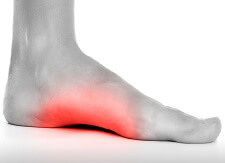- Home
- Diagnosis Guide
- Foot Lumps
Lump On Foot
Written By: Chloe Wilson BSc(Hons) Physiotherapy
Reviewed By: FPE Medical Review Board
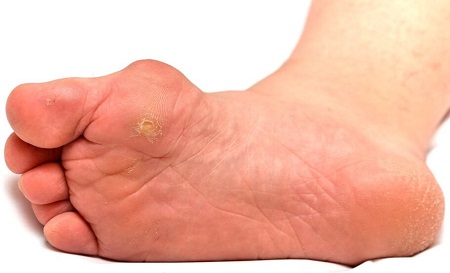
A bump or lump on the foot is a common problem.
There may be a hard foot bump or a soft, squashy one.
The lump may be on the top of the foot, the side, the heel, the toes or there might be a bump on the bottom of the foot.
The size, location and feel of the lump on the foot will indicate different foot problems, as well as any other associated symptoms such as tingling, swell, redness and heat.
Here we will look at common causes of foot bumps and lumps and how to work out what is causing your lump on foot, and then we’ll go on to look at how to treat them.
So if you, like so many others you are asking “what is this bump on my foot?” keep reading!
What Causes Foot Bumps & Lumps?
There are so many different causes of a lump on the foot that it can be hard to work out which one you have. So we are going to look at the different types of foot lump that commonly affect different areas of the foot.
1. Lump On Top Of Foot
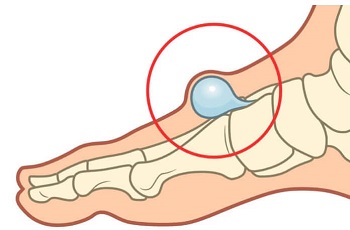
One of the most common places to get foot bumps is on the top of the foot. There are lots of possible causes of a bump on top of the foot, the most common being:
- Bone Spurs: hard lump on top of foot caused by excess bone
- Ganglion Cyst: smooth, spongy bump on top of foot. Most common in 20-40 year olds
- Gout: Swollen, red, hot big toe that is extremely painful. More common in men
- Lipoma: Soft, fatty lump on foot just under the skin
- Fractures: painful lump on foot following injury or over-training
- Bunions: hard lump on foot where big toe starts to shift inwards
There also a few other things that can cause a lump on top of the foot including bursitis (inflammation of small fluid-filled sacs) and tendonitis (inflammation of one of the foot tendons).
You can find out all about these different types of foot lumps and bumps in the Lump On Top Of Foot article, including how to tell what is causing your lump on foot and how to treat it.
2. Lump On Side Of Foot
Another common place to get a lump on the foot is around the side of the foot. Common causes of a bump on the side of the foot include:
- Tendonitis: Diffuse swelling on side of foot. Foot lump may be on inner or outer side of the foot depending on which tendon is affected
- Plantar Fibroma: small, firm bump on side of foot, typically in the arch. More common in men
- Bunions: Hard lump on side of big toe or little toe. Most common in women who wear tight, heeled shoes
- Corns & Calluses: hard, thickened lump on foot skin
- Cuboid Syndrome: small, hard lump on side of foot caused by dislocation of one of the small foot bones usually from an ankle sprain
Other possible causes of a bump on the side of the foot include bone damage e.g. fractures, excess bone growth e.g. accessory navicular bone, and cysts e.g. ganglion or sebaceous cysts.
If your foot bump is around the side of your foot or in the foot arch, have a look at the lump on side of foot article for help working out what is causing your lump on foot and how to treat it.
3. Bump On Bottom Of Foot
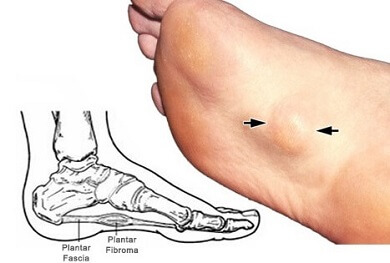
Another common place to get a lump on your foot is underneath the foot, or a foot arch lump, which may be caused by:
- Plantar Fibroma: small, hard nodule or cluster of lumps in foot arch – may feel like there is a stone in your shoe
- Morton’s Neuroma: lump on foot between toes that causes sharp, stabbing, burning pain under the foot and, in some cases, tingling
- Plantar Fasciitis: inflammation of the plantar fascia often associated with a hard lump on foot from a bone spur where the tight plantar fascia has pulled on the heel bone
- Plantar Wart: small, painful lump on foot, usually skin coloured with black dots.
- Dyshidrotic Eczema: lots of tiny, itchy bumps on bottom of foot filled with fluid
Other possible causes of a lump on foot arch or underneath the foot include corns and calluses (hard, thickened areas of skin), cysts/benign soft tissue tumors and Charcot Marie Tooth Disease (a type of peripheral neuropathy).
If you want help working out which of these is causing your lump on foot, check out the Bump On Bottom Of Foot article which will tell you everything you need to know about the causes, symptoms, diagnosis and treatment of your lump on bottom of foot.
4. Lump On Heel Of Foot
Another common place to get lumps on the foot is around the heel bone. Common causes of heel lumps are:
- Heel Bursitis: inflammation of the fluid-filled sac that sits between the heel bone and Achilles tendon. Causes a soft, squashy lump on the back of the heel
- Heel Bone Spurs: excess bone growth causes a hard heel lump on foot. May be linked with Achilles tendonitis at the back of the heel, known as Haglund’s Deformity, or linked with plantar fasciitis which causes a hard foot lump underneath the heel
- Achilles Tendonitis: inflammation of the Achilles – the tendon that connects the calf muscles to the heel bone. May cause a bump on heel of foot where the tendon inserts or a couple of centimetres up from the ankle where the tendon is at its narrowest
- Piezogenic Papules: Clusters of small, skin coloured bumps on side of heel common in people who spend a lot of time on their feet
You can find out more about each type of heel lump on foot and the causes, symptoms and treatment options for each in the Lump On Heel Of Foot section.
5. Lump Or Bump On Toe
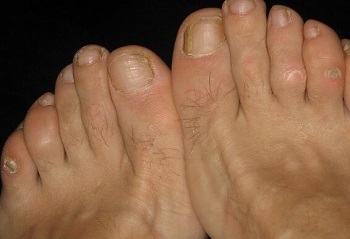
If you have a toe lump on your foot it may be caused by:
- Corn/Callus: hard, thick, raised areas of skin that are caused by excessive friction or pressure on the toes. May develop on the top, at the side or in-between the toes.
- Bunions/Bunionettes: where tight footwear pushes the big or little toe inwards leading to a red, swollen, painful lump on the toes
- Hammer/Claw/Mallet Toes: toe deformities caused by one or more of the toe joints bending out of position which lead to different shaped lumps on toes
- Gout Foot: a gout lump on foot is usually red, swollen and intensely painful. Symptoms develop rapidly and are caused by a build-up of uric acid crystals in one or more of the foot joints
- Digital Mucous Cyst: small fluid, filled lump by or near one of the toe nails, often linked with arthritis
- Sesamoiditis: inflammation of the small bones that sit underneath the big toe
You can find out more about the causes, symptoms, diagnosis and treatment of these different types of toe lumps and bumps in lumps on toes, or alternatively visit the toe pain section.
How To Treat Foot Lumps & Bumps
Treatment for a lump on your foot will depend on the underlying cause of your foot bump and may include a combination of home treatments and medical interventions. Lump on foot treatment typically involves a combination of:
- Pain Relief: if your foot bump is painful your doctor may recommend pain medication or anti-inflammatories as part of your lump on foot treatment
- Orthotics: specially designed inserts for your shoes help to improve foot position and take pressure off your foot lump
- Stretches: stretching the foot muscles helps to reduce soft-tissue tension which is often linked to a lump on foot
- Changing Footwear: A lump on foot is often linked with tight, restrictive footwear so switching to wide, flat shoes with cushioned soles can really help
- Injections: steroid injections can help to reduce pain and inflammation with a lump on the foot e.g. bursitis
- Surgery: sometimes a hard lump on foot may need to be surgically removed if it is causing pain or limiting function. This may involve removing excess bone, draining fluid or correcting foot position
Lump On Foot Summary
There are many different types of bumps or lumps on the foot that vary in size, shape, texture and location. Different types of foot lump tend to occur in different places around the foot so by thinking about where your foot bump is, it is easier to work out what is causing it, so choose from:
Each type of lump on foot will require different treatment so it is important to know what is going on. And any new foot bump should be checked out by your doctor – in most cases a lump on foot is nothing to worry about but occasionally a foot lump may be something more serious, so get it checked out.
Related Articles
Page Last Updated: 21st November, 2024
Next Review Due: 21st November, 2026
